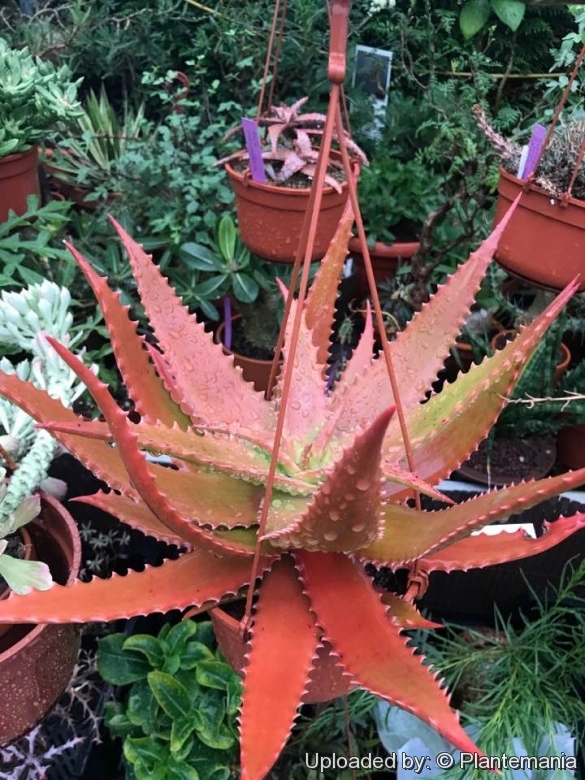
Aloe bussei Photo by: © Plantemania
This is a nice looking stemless, stiff-leaved Tanzanian aloe with an amazing red coloration expecially in hot, dry weather.
Origin and Habitat: Aloe busseiSN|34383]]SN|34383]] is endemic to the United Republic of Tanzania. (Recorded from the following mountain ranges: Uluguru, Ukaguru and Udzungwa. In the Udzwungas presumably only occurs on the north facing slopes over-looking the Ruaha Dam). Estimated area of occupancy km2: 100. Number of Locations10.
Altitude range: 500-1800 metres above sea level.
Habitat and Ecology: Aloe busseiSN|34383]]SN|34383]] is a fairly small succulent shrub growing on open granite rock slabs on small hills and cliffs with deciduous woodland and grasses on deeper soil. Also recorded from woodland with Brachystegia, Combretum, Sterculia, etc. with outcrops of bare rocks with Xerophyta and Aloe. The population are very localized and severely fragmented, but can occur in dense groups. No major threats at present, but there is potential for the species to be impacted by succulent collectors. There may also be impacts through clearance of the habitat by charcoal burners.
Synonyms:
See all synonyms of Aloe bussei
back
Accepted name in llifle Database:Aloe bussei A.BergerPflanzenr. (Engler) IV, 38: 273 1908.Synonymy: 2
back
Description: Aloe busseiSN|34383]]SN|34383]] is a stemless branching shrubby species, that forms dense groups up to 40 cm high.
Leaves: Approximately 20 per rosette, glossy green, flushed red-brown to green-purple, up to 20-30 cm long, 45-60 mm wide in the centre, lanceolate to ovate-lanceolate, tapering, On the underside there are occasionally few white spots. Margins sinuate-dentate, with cartilaginous edges, teeth white or pale yellowish 2-3(-5) mm long inclined toward the tip of the leaf, 7-8(-15) mm apart.
Inflorescence: Erect simple or usually with 1-2(-4) branches, 40 to 60 cm (rarely up to 75 cm) Raceme more or less dense, conical-cylindrical, (15-)18(-25) cm long, stalked. Bracts ovate-pointed 4 to 6 mm long, 3 mm wide.
Flowers: 28 to 35 mm long and narrowed at their base, coral red, yellowish at their mouth. Corolla narrowed into the 8-10 mm long pedicel. The ovary is 6 mm in diameter slightly narrow above, then the tube expand to 8 mm and narrows again at the mouth. Outer perianth segments (tepals) not fused at the base12 to 15 mm long. The stamens and the stylus protrude slightly from the flower.
Bibliography: Major references and further lectures
1) Eastern Arc Mountains & Coastal Forests CEPF Plant Assessment Project Participants. 2009. Aloe bussei. The IUCN Red List of Threatened Species 2009: e.T158040A5184534. http://dx.doi.org/10.2305/IUCN.UK.2009-2.RLTS.T158040A5184534.en. Downloaded on 08 September 2017.
2) Hermann Jacobsen "A Handbook of Succulent Plants: Descriptions, Synonyms, and Cultural Details for Succulents Other Than Cactaceae", Volume 1 Blandford Press, 1960
3) Hermann Jacobsen, "Abromeitiella to Euphorbia", Blandford Press, 1960
4) Susan Carter, John J. Lavranos, Leonard E. Newton, Colin C. Walker: Aloes. The definitive guide. Kew Publishing, Royal Botanic Gardens, Kew 2011
5) Leonard Eric Newton: Aloe bussei. In: Urs Eggli (Hrsg.): "Sukkulenten-Lexikon. Einkeimblattrige Pflanzen (Monocotyledonen)". Eugen Ulmer, Stuttgart 2001
6) Urs Eggli, "Illustrated Handbook of Succulent Plants: Monocotyledons". Springer Science & Business Media, 17 July 2001
7) Urs Eggli, Leonard E. Newton: "Etymological Dictionary of Succulent Plant Names". Springer, Berlin/Heidelberg 2010
8) Jan-Peter Frahm, Jens Eggers: Lexikon deutschsprachiger Bryologen. 2. Auflage, 2001, Band 1
9) Alwin Berger: "Liliaceae-Asphodeloideae-Aloineae". In: Adolf Engler (Hrsg.): "Das Pflanzenreich. Regni vegetablilis conspectus." Heft 33, Wilhelm Engelmann, Leipzig 1908. Web: http://www.biodiversitylibrary.org/page/20872118#page/279/mode/1up
 Aloe bussei Photo by: © Plantemania
Aloe bussei Photo by: © PlantemaniaSend a photo of this plant.The gallery now contains thousands of pictures, however it is possible to do even more. We are, of course, seeking photos of species not yet shown in the gallery but not only that, we are also looking for better pictures than those already present.
Read More... Cultivation and Propagation: Cultivation is not difficult as long as good drainage is maintained. Move it to the sun to maximize colouring.












